Ancient Salona Research: Sensational New Archaeological Discoveries
February 25, 2023 - The latest discoveries in Salona, an ancient city near Split, show that the site is almost a third larger than previously known and confirm that ancient Salona was a large city in an extremely important strategic position of the Roman Empire. The value of these discoveries is sensational, according to the conservators.
"These discoveries and their presentation will soon become a great archaeological sensation like the world-famous Aquileia and Pompeii and will have a significant share in the economic development of the city of Solin," Radoslav Buzancic, head of the Conservation Department in Split, said for Hina, as reported by Poslovni.
The presentation of the ancient Salona will be developed through the generations and long into the future, he said, noting that some newly discovered finds, such as mosaics, will be presented in the Cultural Centre. "It is not one project, but many projects with the same goal, financed from different sources," Buzancic pointed out, adding that "the process of the physical presentation of the ancient Salon in the city and outside it is related to future research and spatial planning policies of the city, which the Ministry of Culture and Media has always supported."
The latest research carried out south of Gospin Otok on the left bank of the river Jadro revealed parts of the city ramparts that give a new image of ancient Salona and show that the city was larger than previously thought. These ramparts, Buzancic explains, stretch south of Gradina to Marko Marulic Street, from where they turn west to Sirina.
The analysis of archaeological research has established, he emphasizes, that Gospin Otok, as well as the entire part of the city to Maruliceva Street, was located inside Salona. In archeological research on Sirina, walls that we know from 19th-century blueprints were found, towers that were not drawn at the time, and economic complexes of buildings within those walls.
The new findings shed an entirely new light on ancient Salona
New finds, not only the ramparts of the southern part of the city, but the sensational finds of monumental buildings and infrastructure, as well as the finds of stone sculptures and sculptures found in these investigations, shed a completely new light on ancient Salona, Buzancic points out.
Among them, he singles out "the imperial building with mosaics between the post office and the monastery of the Sisters of the Handmaids of Little Jesus, the ancient road with a huge canal opposite the same monastery, the large thermal baths that have only been partially explored on the stretch from Tuđmanova Street to the City Administration building, as well as the southern gate of the city which are located under the road in Petra Kresimira IV Street, together with the previously found channel and bridge north of Tudmanova street."
Salona, Buzancic explains, is a huge Roman city with Illyrian and Greek roots. It was the port of Delmata until the age of Augustus. It began to develop as an important urban center of Illyricum, with new walls and monumental gates, a forum, and temples erected.
The Flavian dynasty left a memory of its rule in the vast arena built west of the old city. In the time of Marcus Aurelius, in the middle of the 2nd century AD, the city, walled with ramparts and towers, reached the size of what, Buzancic notes, was considered the ancient Salona until recently.
"It was a significant city in an important strategic position, the center of Illyria, which was destroyed and rebuilt many times because of this. It flourished in the period from the creation of the Roman Empire to the Gothic Wars, was rebuilt into a large and important late antique center, with the seat of a huge archdiocese that reached to the Sava and the Danube to the north, destroyed by the invasion of the Avars and left to the Croats, who built the center on the ruins of Salona his medieval state", he explains.
Salona, Buzancic points out, has great importance for Croatian history and statehood, as well as an educational character that brings knowledge of such an important ancient center of the Mediterranean. According to him, it is also a huge Christian archaeological site with a history that goes back to the apostolic times.
Ancient Salona research will continue
The latest discoveries in Salona are the work of the skill and expertise of Croatian conservators. According to Buzancic, who were never behind the Italian ones, Salona was better protected than the famous Pompeii, which experienced great devastation a few years ago when entire parts of attractive ancient buildings collapsed.
"In the past, the buildings in Salona were destroyed so that the enemy army would not use them as fortifications, but the construction was still so solid that despite all that, it was not completely destroyed," explains Buzancic .
He adds that parts of the architecture partially preserved as ruins were once extremely sensitive to earthquakes. "This can be a great danger, especially if it is a question of slender columns on which parts of a massive structure are located," warns Buzancic.
In Solin, there have been protective archaeological investigations for years, which, he reminds, necessarily precede construction works and are financed by the Investor. Systematic archaeological research in Salona is financed from the state budget and EU funds, and some research is co-financed by the City of Solin.
Salona's research will continue. Thus, the insights into the ancient past of the current Solin region will continue to expand. The discoveries bridge the almost two-millennium time gap between the current Solin and the former Salona, a fortress of the Roman Empire in Dalmatia. The exciting archaeological story of Salona turns into a promising magnet for visitors.
For more, make sure to check out our dedicated Travel section.
8th Croatian Football Federation Executive Board Session Held in Solin
June 7, 2022 - The 8th Croatian Football Federation Executive Board session was held in Solin on Monday, at which a decision was made on the names of men's football competitions in the upcoming season.
On Monday, the Croatian Football Federation Executive Board met in Solin ahead of the UEFA League of Nations match between Croatia and France at Poljud, reports HNS.
A decision was made that the highest level of competition in men's football will again be called the Croatian Football League, while the second, third, and fourth levels will be called, respectively, the First Football League, the Second Football League, and the Third Football League. Subsequently, it is possible to add to these names the name of the title sponsor of each level of competition.
"We wanted to single out the first stage of the competition and give additional importance to the lower stages of the competition, so we considered several solutions. In the end, we decided to return the first stage of the competition to its original and recognizable name, Croatian Football League, which has become common among fans, in public, and in the media, which we have witnessed in recent years when the name was the First League, but we all said that it is ours - HNL.
In this way, we paid tribute to the history and recognition of the HNL while avoiding international expressions such as "premier" or "elite," which have no tradition in Croatian football. We have also emphasized second, third, and fourth level clubs. Furthermore, we will continue to strengthen all marketing, promotional and commercial aspects," said HNS President Marijan Kustić.
The Executive Board also accepted the decision on distributing funds from the TV rights contract, whereby the largest part will go to the clubs of the Croatian Football League - 9.33 million euros. The rest of the funds will be directed to the First Football League, 1st ŽNL, 1st HMNL, HNK for youth, HNK for women, and HNK in indoor soccer.
The Executive Board determined the participants in the competition from the first to the third level, i.e., the qualification for the First and Second Football Leagues.
The new Ordinance on Football Competitions, the Ordinance on Club Cooperation, the Licensing Report for the Competition Year 2022/23, the Report on the Organization of Football Camps in Australia and the USA, and the document Basics of Veteran Football were adopted.
The Executive Board also decided to purchase artificial grass needed to build seven more lawns in counties across the country.
For more, make sure to check out our dedicated sports section.
Split Destinations You Can Visit Using Public Transport
May 24, 2022 - You can spend a large part of your itinerary in the city centre, but did you know that you can get to know many interesting Split destinations by bus? We're going to show you how.
Whether it is a short visit or for a week, the City of Split can fill your itinerary with activities of all kinds, sights, gastronomic spots, and much more. But what if you feel the need to explore your surroundings? Surely from the window of your plane, shortly before landing, you noticed that Split is much more than just its centre. In the high season, you may want a little respite from the crowds, so why not explore some of the nearby Split destinations? By using public transport, you can save yourself the fees of renting a car to visit these relatively local destinations, as well as the tedious search for parking in the city.

Photo: Ivo Cagalj/PIXSELL
The public transport system in the City of Split is called Promet (Traffic) and its buses can take you beyond the centre. The bus network is divided into four zones, and that is how ticket prices are determined (based on proximity to the very centre). If you're very clear about where you're going, you can buy your tickets at the Tisak stands indicating the area you are going to, or you can also pay the bus driver himself, indicating the exact destination you are going to.
The prices of bus tickets by zone are as follows:
Zone 1: 9 kuna
Zone 2: 13 kuna
Zone 3: 17 kuna
Zone 4: 21 kuna
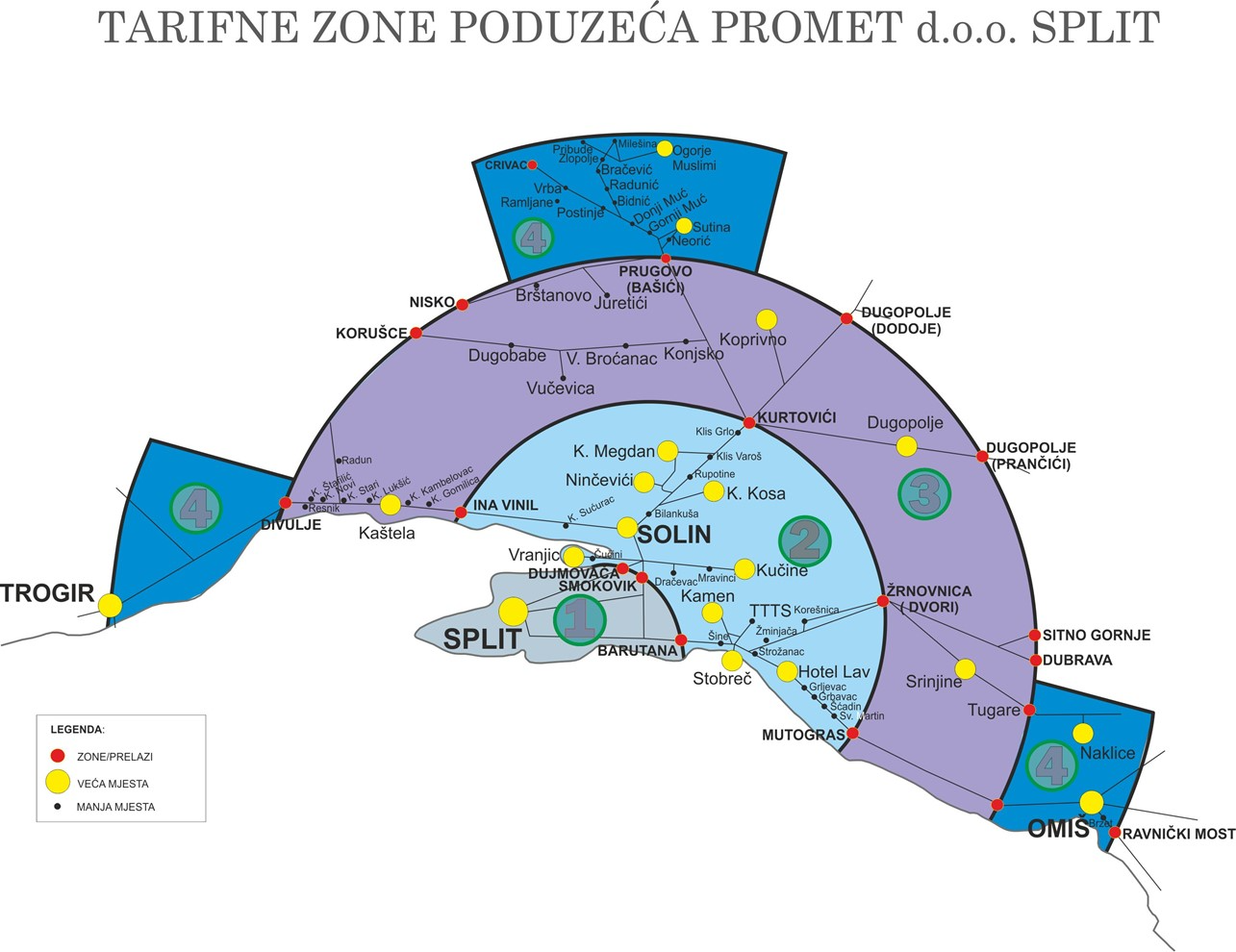
Image: Promet Split
Now, the question is, where do you want to go? Generally, everything in the centre of Split is part of Zone 1. You can choose between beautiful and less crowded beaches, small and picturesque old settlements, or even historical places beyond that zone. The choice is yours. Here are some ideas for Split destinations you can visit in zones 2, 3 and 4 with the city's public transport system.
ZONE 2
Solin
Solin is located very close to the centre, just northeast of Split. Originally called Solana, it was a Greek colony founded in the 3rd century BC, and later a Roman colony. At that time, it ended up becoming the fourth largest city in the entire Roman Empire. For a zone 2 ticket to Solin, you can go ahead and visit its impressive ruins. You'll need to get on bus number 2 (Split - Poljička - K. Sućuraj (Strinje) - Split Airport), or bus number 38 (Split - K. Stari - Resnik).
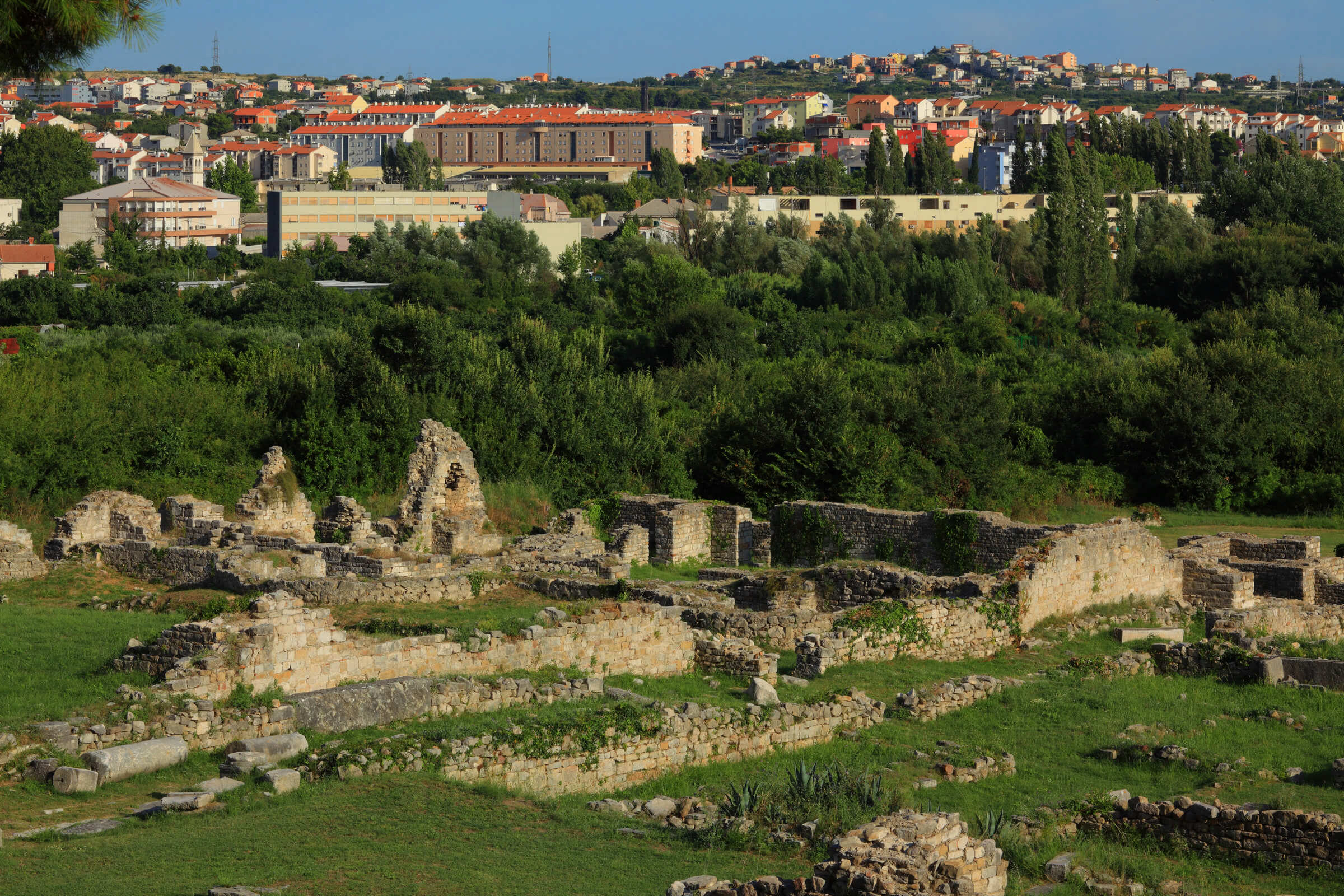
The ruins of Solin. (Photo: Mario Romulić)
Stobreč
On the southern loop of Split zone 2, Stobreč is the first destination you can get to. It's ideal if you are looking for somewhere nearby to relax and with a good number of bars and restaurants. Stobreč also has a golf course, if that's your thing. You'll need to get on bus number 60 (Split-Omiš) or number 25 (Split-Stobreč).

Overview of Stobreč. (Photo: Mario Romulić)
Podstrana
Passing Stobreč, you'll reach Podstrana. Podstrana has a large number of beautiful beaches, with bars and restaurants on them. I always say, if you are looking to enjoy the sea in Split and away from the crowds, go to Podstrana. If you're looking for something other than the beaches, you can also go hiking in the surrounding hills or kayaking on the Žrnovnica river. Did you also know that legends say that Podstrana is where the famous King Arthur could have been buried? You'll need to get on bus number 60 (Split-Omiš) to get here.
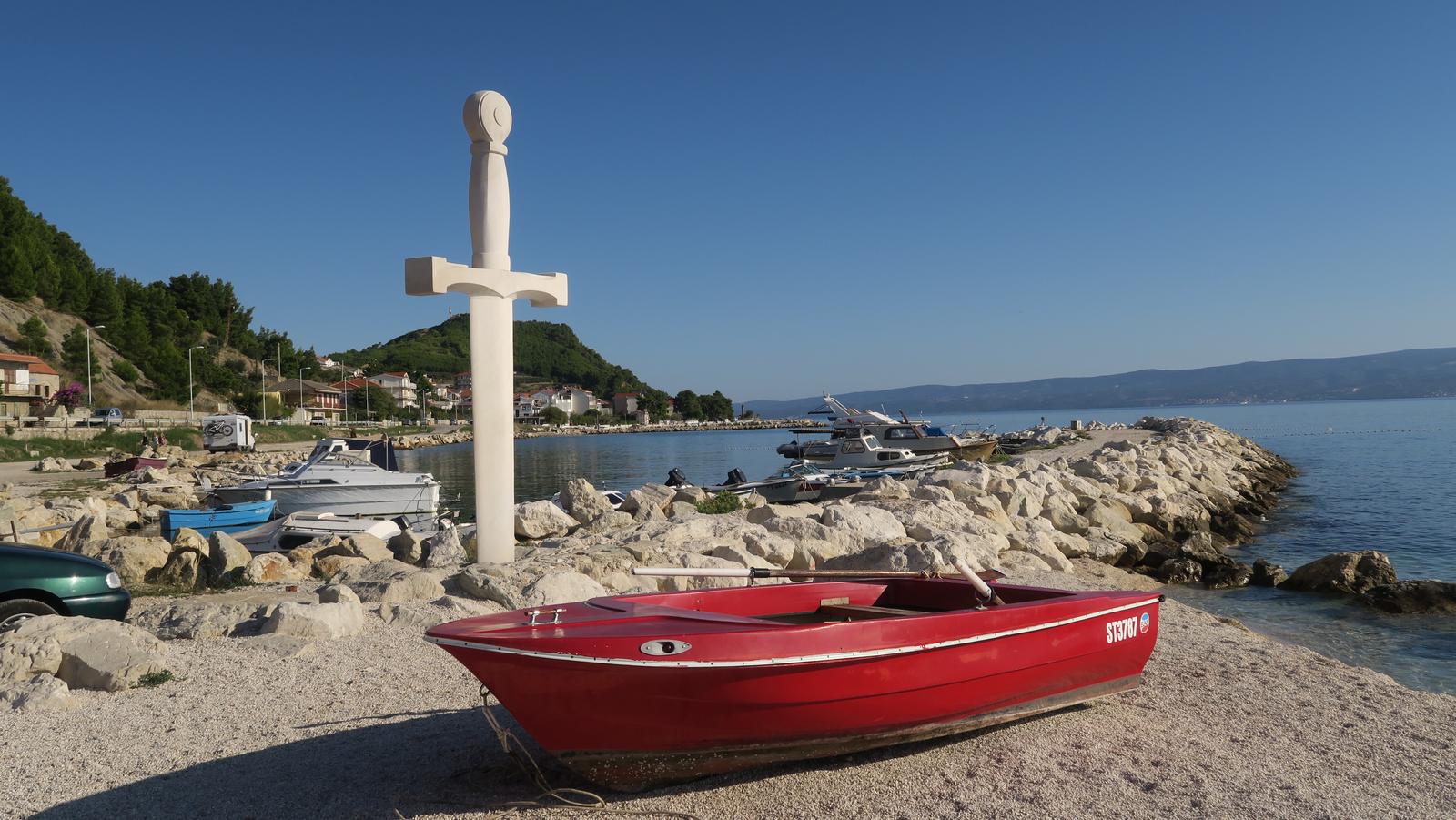
The sword of Artorus, in Podstrana. (Photo: Ivo Cagalj/PIXSELL)
ZONE 3
Kaštela
Please note that there is more than one Kaštela! It won't be something that will have much relevance when paying for your ticket, since they're all in the same area. Kaštela is located northwest of Split, on the way to the airport. No matter which Kaštela you decide to go to, be sure to enjoy its promenades, beaches, and marinas! You'll need to get on bus number 2 (Split - Poljička - K. Sućuraj (Strinje) - Split Airport), or bus number 38 (Split - K. Stari - Resnik).
Krilo
If you pass Podstrana, heading south, you will enter zone 3. There are many places that you can visit almost in succession: Mutogras, Jesenice, Sumpetar, Dugi Rat... Krilo has very nice beaches, as well. You'll need to get on bus number 60 (Split-Omiš).
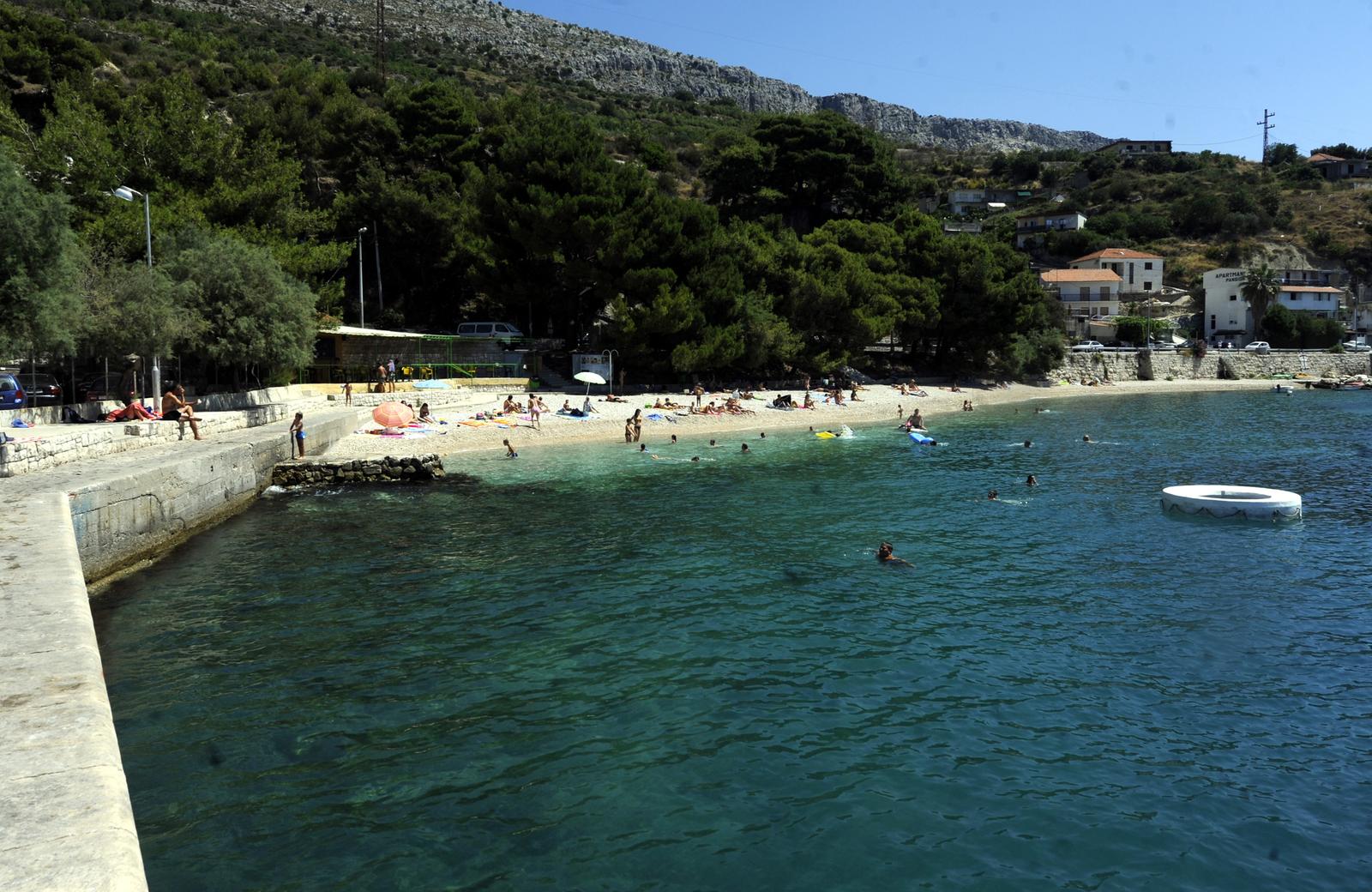
Krilo. (Photo: Tino Juric/PIXSELL)
ZONE 4
Duće
Duće is one of the last destinations in zone 3 to the south. Many continue on to Omiš, but Duće is a place that deserves all your attention for its beautiful beaches and camping sites. You'll need to get on bus number 60 (Split-Omiš).

At the beginning of Zone 4, just before Omiš, you'll find Duće. (Photo: Mario Romulić)
Trogir
Passing the Split Airport, you'll find the very ancient and picturesque town of Trogir. Often regarded as the miniature version of Split, its beautiful promenade and narrow streets will stick in your mind for a long time. A good idea is to find pristine beaches in the bridge-connected island of Čiovo. You'll need to get on bus number 37 (Split - Split Airport - Trogir).

Trogir. (Photo: Mario Romulić)
Omiš
Omiš is one of the most popular and largest towns on the coastal road between Split and Dubrovnik. Just 40 minutes from the center, Omiš is a true jewel of the Dalmatian coast, with beautiful old streets, the Cetina canyon, and wonderful beaches. You'll need to get on bus number 60 (Split-Omiš).

Omiš. (Photo: Mario Romulić)
For more information on Split's bus system, be sure to check the official website of Promet.
For more on travel in Croatia, follow TCN's dedicated page.
Ancient Salona Archaeological Discovery: Peacock Mosaic, Symbol of Eternal Life
January 25, 2022 - Another ancient Salona archaeological discovery reveals a stunning peacock mosaic depicted in early Christian art as a symbol of resurrection and eternal life.
The beautiful ancient mosaics discovered recently in the center of Solin caused a sensation in archeological circles, but also beyond. The probable floor of some Roman villas on the outskirts of Salona may shed new light on the area where the capital of Roman Dalmatia stretched. And not only that, but this is one of the few findings that can show how people lived in Salona, reports T.portal.
Apart from the profession's interest and the work that restorers are currently doing on mosaics, the main issue is the future presentation of one of the critical Salona discoveries in the last few decades. As things stand now, the mosaics will be covered with glass and get a well-deserved place in the future city cultural center, which is why the works that led to the discovery began in that area.
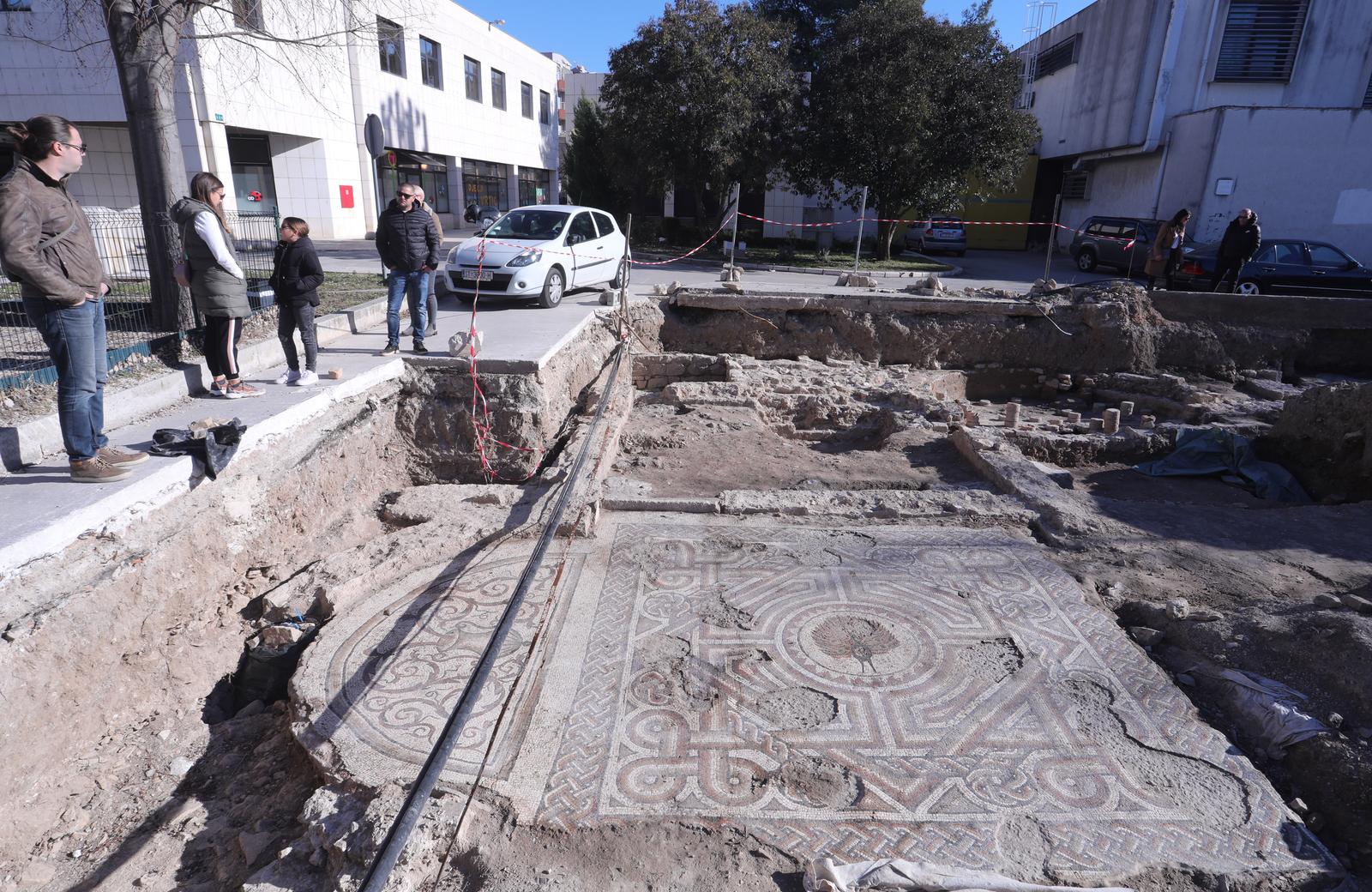
Ivo Cagalj/PIXSELL
With underfloor heating installations and a beautiful small mosaic with flowers, the main discovery is undoubtedly a giant mosaic with more decorative details - an image of a peacock. It may be that the former villa owner, unknown to us today, admired the beauty of this bird. Still, according to some experts, the depiction of a peacock may indicate when the villa was built, i.e., in early Christianity, from the 4th century onwards (Salona was abandoned in the first half of the 7th century). The reason is the significant symbolism of the peacock in the Christian religion.
Peacocks are usually depicted in early Christian art as a symbol of resurrection and eternal life. Such a meaning probably comes from pre-Christian religions, from Greek to Jewish. It was believed that peacock meat did not decay even after death, so they considered it a symbol of eternity. The belief was also passed on to Christians, who portrayed this bird as a sign of Christ's eternal existence. St. Augustine tested this thesis in practice and was surprised at how long the meat remained undigested. In "The State of God," he even wrote about his experiment: "a year later, it remained the same, except that it dried up." These are all reasons why this bird can be seen in catacombs and tombs because it reminds believers of the soul's immortality.
In the Middle Ages, this was supplemented by the fact that the peacock sheds its feathers every year, and new ones grew even more beautifully than before. Legends also said that the beautiful colors of peacock feathers come from food, that is, that a peacock can kill and eat venomous snakes, whose venom 'turns' into miraculous feather colors. It was similar, it was believed then, with Christ: he dies for us on the cross, then rises from the dead by defeating evil by taking divine form, and with healed wounds. It can also be said that the peacock - whose beauty is not always visible - symbolizes a Christian who has attained eternal life by faith and has shown all his greatness by resurrection, just as a peacock spreads its spectacular tail on special occasions. Interestingly, in later times, and even today, the peacock was seen more as a symbol of vanity.
The peacock's tail had another meaning - the 'eyes' at its ends reminded Christians of the God who sees everything. For example, the pillars of Theodosius' Forum in Constantinople, today's Istanbul, were decorated with that part of a peacock's tail.
We can only hope that the announcements about the presentation and (more importantly) preservation of this finding will come true, and that it will not experience the fate of the most famous Salona mosaic, a depiction of two deer drinking water and the inscription 'As a deer longs for a spring of water, so my soul longs, God, for You.' Namely, this mosaic disappeared between the two world wars, and today there are only replicas and paintings.
For more, check out our dedicated lifestyle section.
Archaeological Discovery: Ancient Salona Ramparts Uncovered
January 7, 2022 - Under the layers of earth, vegetation, and garbage, well-preserved ancient Salona ramparts have been discovered.
No one has recently passed Porta Caesarea, the eastern and oldest city gate on the way to the amphitheater, without being surprised by the discovered northern ramparts of Salona, the former metropolis of Roman Dalmatia, reports Slobodna Dalmacija.
Under the layers of earth, vegetation, and garbage, one of the best-preserved parts of the Salonitan rampart, "70 meters long" and "120 meters" in length, has been revived.
This research project began in mid-November last year. It will continue in the next period as there is excellent potential for discoveries and new knowledge about life in ancient Salona.
"This is a continuation of the successful cooperation between the Department of Archeology of the Faculty of Philosophy in Zagreb and the Archaeological Museum in Split, which has been going on for four years now.
The research on these northern ramparts is part of the project "New Lives of Ancient Inscriptions: Epigraphic Spoli in Central Dalmatia", which deals with re-used ancient inscriptions funded by the Croatian Science Foundation. Our goal is to explore this and find ancient inscriptions within that research because we know that they were used extensively in the construction of Salona's defensive walls.
This has been confirmed many times so far because, for the two hundred years that Salona has been researched, there have always been inscriptions that ended up in the ramparts as a building material," explains Dino Demicheli, associate professor at the Department of Archeology and project leader.
"With this campaign, we wanted to discover and present the best-preserved section of the ramparts that can be visually experienced in Salona. It is this move east of the amphitheater, along the northern ramparts.
We knew that there were ramparts and towers here. Still, they were so covered with stones, vegetation, earth, that this view simply could not be experienced, unlike what you can see after three weeks of research," Demicheli explains what they have discovered.
"These towers, which are numbered from 15 to 18 in professional literature, can now be seen very nicely, and our goal is to preserve them as soon as possible, protect them from collapsing and, of course, present them," says the expert, explaining how the construction of this ring of ramparts began in 170 AD, but how the defensive walls were constantly repaired or upgraded after that.
"Here, you can see the ramparts, towers, and these triangular protrusions that were upgraded only in late antiquity; it is the latest phase of construction, the fifth and sixth centuries AD.
All four towers are different in appearance, construction, and size. Nevertheless, these are really impressive remains, and even when you imagine that these towers went another five to six meters in height, you can imagine what the Roman defense system looked like at that time," he adds, emphasizing that it is essential that they confirmed the project goal and found more than 30 epigraphic monuments, i.e., exteriors.
"We have established that epigraphic monuments were used for this extension of the ramparts and that they were mercilessly inserted as construction material from the surrounding area.
These are ancient tombstones, more or less dating between the first and third centuries, and were installed, we assume, during the fourth and fifth centuries.
The ramparts are currently the greatest epigraphic resource in Salona; we find so many of them here that it is fascinating. All the necropolises were outside the city, and the ramparts were being built right on the border between the "living" city and the pagan necropolis outside Salona, which were in some way deconstructed and inserted into the ramparts.
So, in a way, they have been preserved thanks to that," Demicheli points out, saying that they found some fascinating inscriptions.
One of them is an inscription mentioning Vital. He was one of the slaves who took care of the affairs of some very well-to-do Romans.
"At the same time, the archeological research of one of the towers began. By the way, we are now in its lower layers, while the operable part of the tower and ramparts was much higher above us.
We were amazed that along with amphorae and tegulas, we found a lot of ceramics, especially tableware, and increasingly finer pieces. However, now all this needs to be cleaned, washed, determined and defined by century.
We are only in the first layer, so who knows what is down there," says the project manager and points out that it will take time for all this to be methodologically arranged.
Deputy Head of Research Ema Višić Ljubić, senior curator of the Archaeological Museum in Split, emphasizes the importance of cooperating with the Zagreb Department of Archeology and their students. It all started in 2018 with the research of the building with the Episcopal Center and continued with the protective research of the Gradina fortress.
With all the above and current research, we discover new buildings and gain insights about Salona. Most of the knowledge that our predecessors left us in professional literature has been confirmed, and it is incredibly fascinating how many tombstones we have found.
We are delighted because this opens a new story about Salona; we learn a lot about its population and life in it. Nearby is the early Christian site of Kapljuč, which previously had the stage of a pagan cemetery, so a lot of material was built into the ramparts from that site.
Indeed, this complements our knowledge of Salona we have inherited since the beginning of our research," says Višić Ljubić. The project included research associate Ana Demicheli and the Archaeological Museum and senior curator Jagoda Mardešić and Nino Švonja, curator of the epigraphic collection.
"This is the longest stretch of the ramparts that can now be seen from the outside, so only here can the visitor experience the defensive power of Salona with all these towers that are especially dense on the north side of the walls," adds archaeologist Mardešić.
"Mostly there is still work to be done on conservation, on partial reconstruction, but we are very pleased that we have started this process," Mardešić points out.
The importance of the entire campaign is confirmed by Dr. Ante Jurčević, director of the Archaeological Museum.
"The arrangement of the ancient northwestern ramparts began at the end of 2020, removing vegetation but also large debris, mostly of asbestos origin, which was dumped next to the towers in large quantities. Since the towers are next to the central communication, i.e., the road, it was convenient for people to throw garbage there.
After these works, research began, which included towers and cleaning the front walls, and the Archaeological Museum continued to clean the entire area to the amphitheater.
We cleaned about two hundred meters of low vegetation, removed most of the bulky waste from the surface of the towers and ramparts. Our goal is to present the rest of these towers that connect to the amphitheater in the same way by the end of 2022 so that this whole move from Kapljuč to the amphitheater is preserved and presented.
The northwestern ramparts are being arranged with the help of the Croatian Science Foundation, the Ministry of Culture, as well as our museum funds," says the director and announces that they plan to arrange an early Christian cemetery in the second phase of organizing and cleaning the Salona archeological site.
"We intend to conserve and finally arrange the tomb of St. Domnius, and then the Episcopal complex from which we want to remove long-standing accumulations of earth and stone that were formed during 50 years of research. This is followed by research, conservation, and site presentation.
Our goal in cooperation with the Croatian Restoration Institute is to arrange the western necropolis, i.e., the part that is currently underwater, as well as the part of the western ramparts that are also overgrown and are located near the entrance to the INA plant in Sveti Kajo," the director announces numerous projects for an even better presentation of these inexhaustible archeological treasures.
Everyone is incredibly proud that this cooperation with the Faculty of Philosophy in Zagreb revived the student fields that existed in the 60s and 70s when archaeologist Duje Rendić Miočević brought students who researched at Porta Caesarea.
Students of the Department of Archeology who participated in this research are Tomislav Kiš, Santa Duvnjak, Vinko Udiljak, Martin Sokolić, and Nera Janković, as well as two doctoral students on the project of the Croatian Science Foundation, Josip Parat and Krešimir Grbavac.
Everyone will continue to work in the field because their experiences in Salona are significant to them. They were supported by the City of Solin, the Tourist Board, and the Public Institution of Culture "Zvonimir".
"This field is fantastic for them; they, like all of us, are fascinated by the result because a lot has been achieved in a brief period, and what makes us happy are the reactions of people who walk through Salona every day. No man hasn’t stopped and said, 'Well folks, this is fantastic, we didn’t even know this was here!'
However, all this needs to be protected, that is, preserved, so we still have a lot of work to do," concludes Demicheli.
You can see photos and videos at Slobodna Dalmacija
To read more about lifestyle in Croatia, follow TCN's dedicated page.
Can You Name the World’s Smallest Town? (And a Few Other Superlatives in Croatia)
Can you name the smallest town in Croatia (and the world)? What about the biggest, oldest, or safest? Take a guess, and then check out our list of champion towns in six different categories
Did you know that the Croatian language doesn’t distinguish between the terms city and town? We call them both grad, which refers to an urbanized area with more than 10,000 inhabitants. Exceptions are made for less populated settlements if they have significant historical, economic or geographic features.
If there’s one thing we don’t lack around here, it’s places of historical significance, and thus our technical nomenclature goes down the drain. You’ll often see very sparsely populated places being referred to as towns - what’s basically a village in terms of population could have easily had a status of a city in medieval times.
When you think about Croatian cities and towns in terms of superlatives - largest, oldest, safest - none of the leading tourist destinations make the cut. The biggest Croatian cities sure have their appeal, but this time around, we’re looking at a few peculiar title holders among Croatian towns.
Smallest: Hum
This medieval hilltop settlement located in central Istria is not only the smallest town in Croatia, but also referred to as the smallest town in the world.
Its exact population is somewhat debatable: Hum had 30 residents at the time of the 2011 census, but more recent sources place the number closer to 20. We’re curious to see what the 2021 census data will show.
Entirely built in stone, Hum is also minuscule in size, but packs a handful of houses, one restaurant, two churches and a cemetery within its town walls. While it's not technically a town, its history, cultural significance and urban structure make it quite a distinctive settlement.
One of the many Istrian legends has it that the giants who built other central Istrian towns in the valley of the Mirna River used the leftover stone blocks to create Hum as one last masterpiece.
It’s a place worth visiting on a tour of Istria: it’s incredibly picturesque and well preserved, is the last stop of the scenic Glagolitic Alley route, and is also the home of biska, a popular Istrian brandy made of rakija, white mistletoe and several other herbs.
Largest: Gospić
Based on population alone, the winner in this category would definitely be Zagreb - expected and a bit too boring for a list of this kind, so we’ll go for different criteria instead. What’s the biggest town in Croatia based on surface area?
If you’d stick with Zagreb as the answer regardless, you’d be wrong. Surprisingly, the biggest town in Croatia only has a population of about 6,500, but is larger in size than Paris, Berlin or Barcelona.
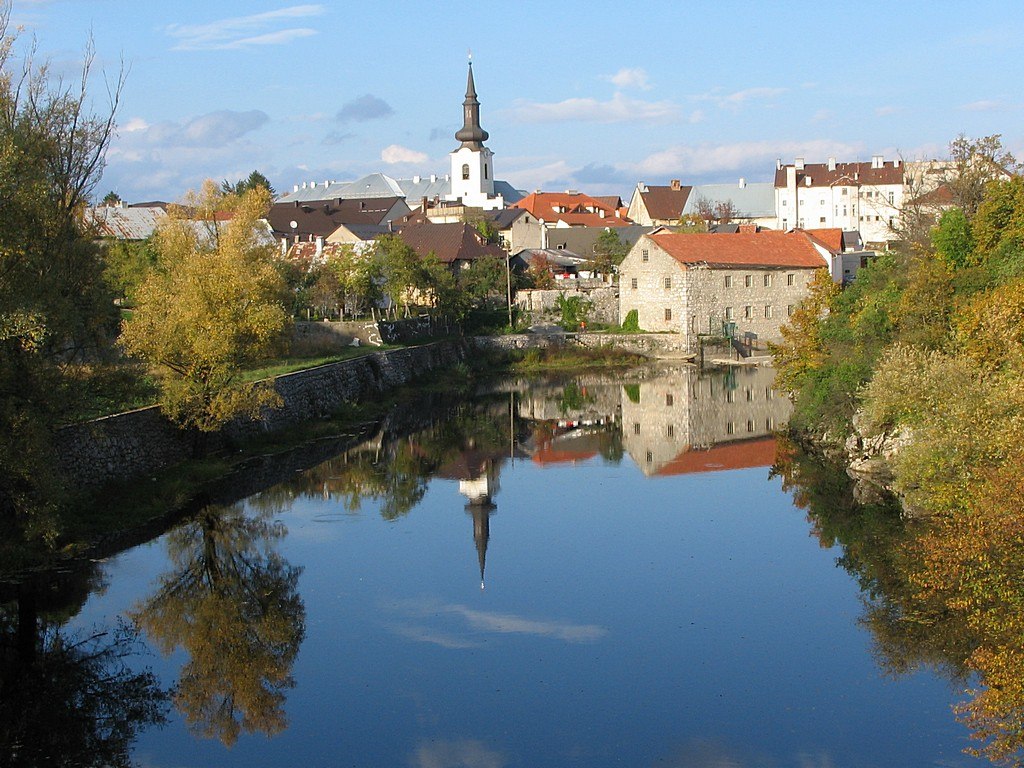
Gospić / iNekic Wikimedia Commons
The biggest town in Croatia is Gospić, with an impressive area of 967 square kilometres. The town itself definitely isn’t that big - it owes its staggering size to some 50 smaller settlements in its wider area that administratively belong to Gospić, as there are no other municipal units nearby to take them under their wing.
Fun fact: Nikola Tesla, the groundbreaking inventor, was born in the nearby village of Smiljan and grew up in Gospić.
Highest: Delnice
Unsurprisingly, we’re heading to a mountainous area to look for an elevation champion. Located in the Gorski kotar region, the town of Delnice sits at an altitude of approximately 700m above the sea level. Its lowest point is situated at an altitude of 210m, and the highest at 1528m!
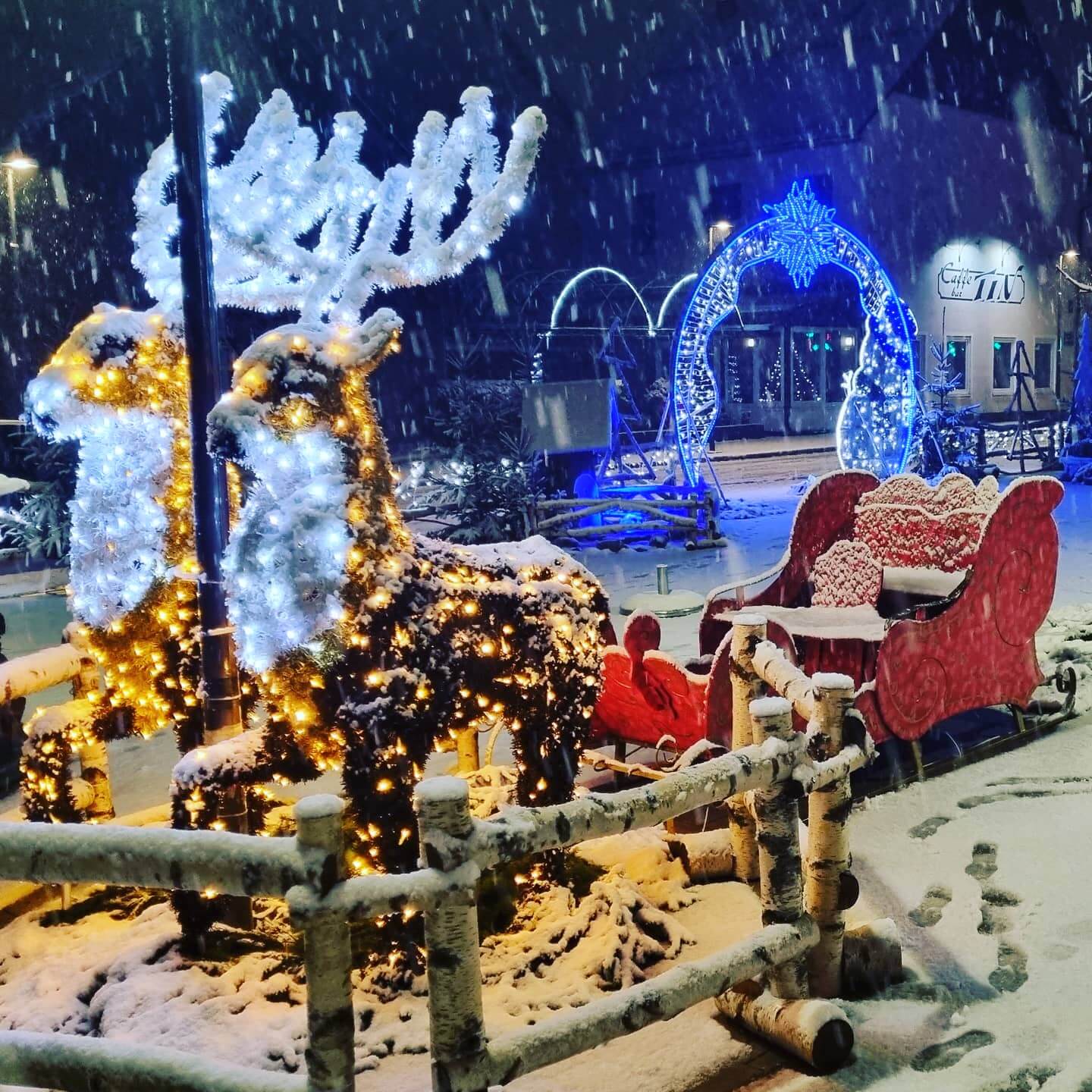
Delnice / Lan Vlad Wikimedia Commons
We’d be remiss not to mention Begovo Razdolje, officially the highest settlement in Croatia at an altitude of 1028m. It’s located in the same region, on the slopes of Bjelolasica mountain, and has a population of 40. While it’s not technically a town, it’s the only inhabited place in Croatia situated at an altitude over 1000m!
Oldest: Vinkovci
In a country that counts an amphitheatre and a Roman emperor’s palace among its cultural monuments, you’d probably look for the oldest settlement somewhere on the coast. And while it’s true that the Adriatic is lined with some of the oldest towns in Croatia, we have to look inland for the oldest of them all.
The town of Vinkovci in Slavonia has been continually inhabited for 8300 years, making it not only the oldest town in Croatia, but Europe as well!
Vinkovci has a lot to be proud of other than its age: it’s the birthplace of two Roman emperors, home to the oldest known calendar in Europe, and hosts the biggest Croatian folklore festival. Check out the 10 things to know about Vinkovci in this dedicated piece.
Youngest: it’s complicated
How to approach the concept of youth when it comes to a town? We can think of three main ways to look at it:
Among the 128 towns and cities in Croatia, Popovača is the one which gained the legal status of a town most recently. It used to be a municipality and was ‘upgraded’ to a town in 2013, effectively becoming the youngest town in Croatia in terms of administrative status.
If we ditch the legal criteria and focus on how long it’s been since the inception of a certain settlement, the youngest town in Croatia is Raša. It’s located in south-eastern Istria and was purposely designed and built as a mining town in the 1930s during Mussolini’s colonization of the region. Two pairs of streets lined with former miners’ houses meet at the central square, where you’ll find the church of St Barbara, uniquely built in the shape of an overturned mining cart.

Raša © Raša Tourist Board
And finally, what about the population? Well, this is a tough one to track down as the demographic situation varies from year to year, and data isn’t always readily available. With apologies to any other town that potentially took over the title at some point, we’ll declare Solin to be the youngest town in Croatia population-wise. Located near Split in Dalmatia, Solin has a population of some 30,000 inhabitants, 6,500 of which are under 18 years of age. The average age in Solin is 34,3 years - well below the Croatian average of 43,6 which ranks us among the oldest populations in all of Europe.
Safest: Sinj
Croatia is widely considered to be a safe country overall. Its population definitely seems to think so: a recent report published by Numbeo and represented on a map by Landgeist shows that Croatia is one of the countries in Europe where people feel safest walking alone at night. It ranks second, after Slovenia - read more here.
What’s the safest place in the second safest-feeling country in Europe, then? For this we turn to actual statistics in an annual report published by the magazine Zaštita and the Faculty of Economics in Zagreb. They rank the 29 biggest Croatian cities and towns according to four separate crime rates (assaults, traffic offences, property crimes and drug abuse).
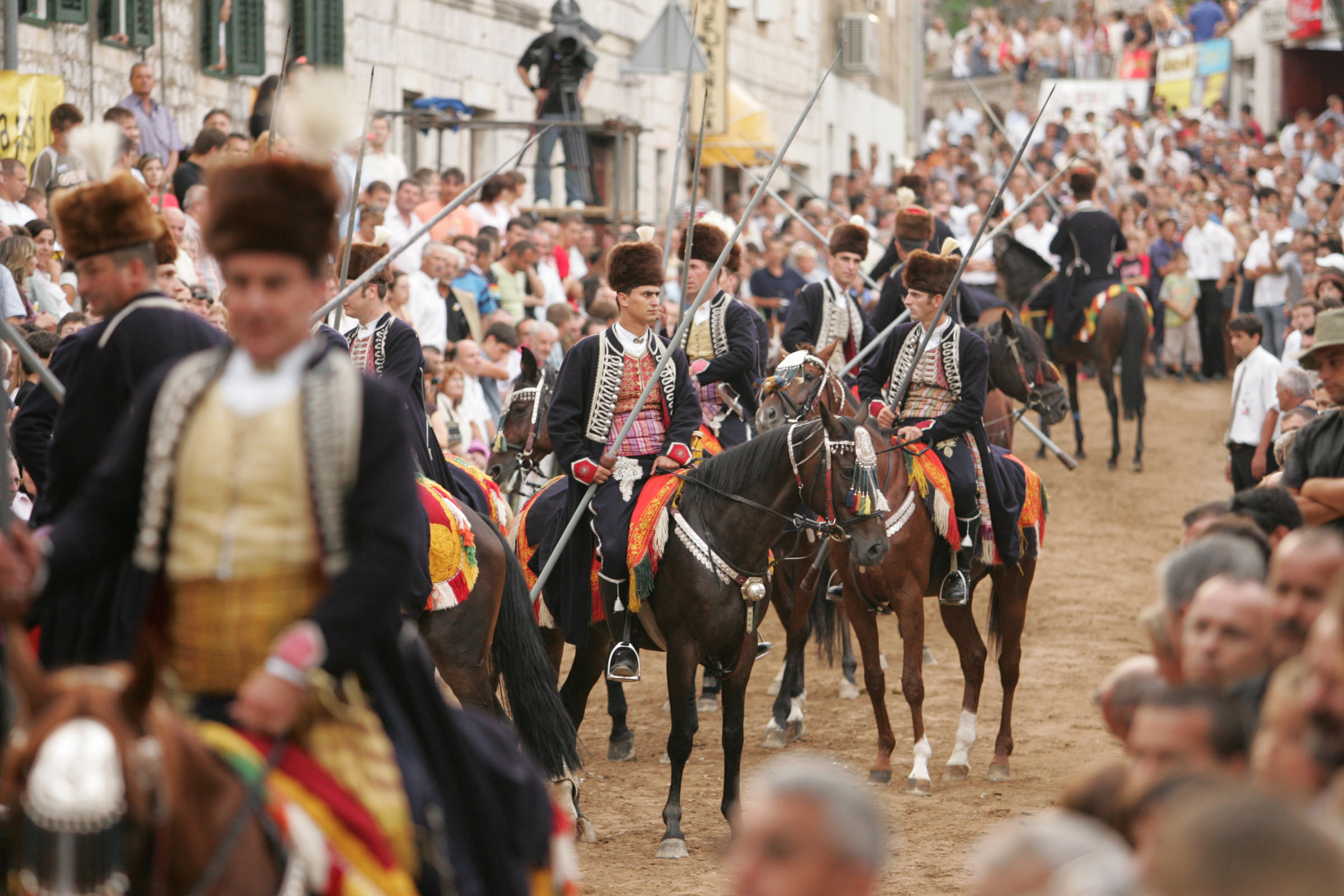
Sinjska Alka © Romulic and Stojcic
The town of Sinj, located in the Dalmatian hinterland, ranked safest in Croatia four times in a row in recent years. It’s a nice title for Sinj and just one of things it’s known for - the most famous certainly being Sinjska Alka.
Inscribed on the UNESCO list of intangible cultural heritage, Sinjska Alka is a traditional knight’s game held every year in August. It commemorates the victory of 700 Croatian soldiers over the army of 60,000 Turkish invaders in 1715 - a report from a reenactment of the battle is available here.
Solin Company Include Begins Production of More Smart Benches
April the 8th, 2021 - The Solin company Include, the first domestic manufacturer of smart benches owned by entrepreneur Ivan Mrvos, has increased its production capacity by five times.
As Novac/Bernard Ivezic writes, on Monday, the Solin startup started mass-producing smart benches and smart waste bins. In one shift a year, 1,300 of them will be made. By comparison, since back in 2016, meaning since the establishment of production, until the end of last year, the Solin company Include has made a little less than 1,600 such items.
The Solin company Include's founder and director Ivan Mrvos has stated that they have launched a new production line worth 1.4 million kuna in total, half of which is co-financed by HBOR, in order to meet the expected growth in demand this year and in the years ahead of us.
''We've already filled our production capacities for the next three to four months with orders from Germany, Singapore and Canada, and as vaccination and the opening up of the economies abroad continue to progress, there's a possibility that we'll be able to open a second shift during the summer months,'' noted Mrvos.
His plan, as he explained, is to increase the Solin company Include's sales to 2.5 million euros during 2021. He expects that within that amount of 2.5 million euros, the new series of Steora smart benches alone will manage to bring in around one million euros, and growth should be generated by their Terra smart waste bins. The company had revenue of about 900,000 euros last year, despite the pandemic. That result, according to Mrvos, is proof that even in dire times, there remains a demand for their smart benches.
''Now we're going one step further and offering smart bins to cities. We have competition, but our bins are 45 percent cheaper than other, similar products and instead of seven to eight years, the cities can return their investment on them in half the time,'' said Mrvos.
He added that they have made more progress with the new generation of smart benches. In addition to the new design, new technology has also been developed, and the new Croatian smart benches can now compete with ordinary, classic benches in terms of price. In the last year and a half alone, Include has invested three million kuna in the development of the new Steora series. A team of 22 experts worked on it, including a doctor of science.
''We can offer more affordable products also because we now have our own serial production. We have machines, a paint shop and other things, and we're employing ten people on the new line,'' concluded entrepreneur Ivan Mrvos.
For more on Croatian-made products and domestic companies, visit Made in Croatia.
Fifth Solin Winterfest: Cultural, Natural, Religious Heritage in 15 Videos
February 10, 2021 – Despite the ongoing coronavirus pandemic, the fifth Solin Winterfest takes place in a virtual edition for the first time. Solin Tourist Board prepared 15 videos in four thematic units – Water, Grace, Heritage, and Love – to present Solin's rich cultural, natural, and religious heritage.
With its 30,000 inhabitants, there are 6,500 young people under 18 and positive demographic growth, and the city of Solin holds the title of "youngest" city in Croatia. Since it's the City of Families and Children's Friend, Solin shows to fellow citizens, visitors, and tourists the importance of family and life with the Winterfest project.
Besides educating its fellow citizens (children and adults) and designing cultural facilities during the winter months, this project aims to develop the off-season tourist offer. Following the strategic goals of tourism development in Croatia, the goal is to position Solin as a destination that lives 365 days a year.

Salona amphitheater / Photo: Romulić and Stojčić
The first unit – Water – presents the project "Jadro – the source of life" for sustainable use of natural heritage through valorization and transformation of previously degraded space into a unique visitor area of a special reserve of endemic species – Solin soft-skinned trout.
The Gašpić restaurant host, Zoran Kljaković Gašpić, better known as Medo, shows in a gastronomic workshop how to prepare trout in broth, a traditional Solin dish.
In a virtual walk through the old Solin mills, in Gašpina mill, one of the few preserved mills on the river Jadro built at the beginning of the 18th century, you can find out what they are and how many of them there were.
The second unit – Grace – is dedicated to the Solin's religious heritage. Find out more about Queen Jelena's reign through the Interpretive Walk "Royal Stories from Solin" – Our Lady's Island, the oldest Marian shrine in Croatia. There is also the Story of the Salonitan Martyrs, told by Don Frane Bulić, a priest and archaeologist, long-time director of the Archaeological Museum in Split, the father of Croatian archeology. Don Fran Bulić was embodied by Nino Švonja, curator of the Archaeological Museum in Split.
In the third unit – Heritage – with Don Frane Bulić, you can also get to know the history of Solin and the Salona site, the largest archeological park in Croatia. The heritage of Prince Trpimir leads to the archeological site of Rižinica, and there is also an Archaeological Workshop.
The fourth unit – Love – places particular emphasis on the family and children since Solin is the youngest city in Croatia due to its positive demographic growth. Also, this unit is associated with the upcoming Valentine's Day.
How many times have we heard that love goes through the stomach? In the gastronomic workshop "Taste the Love," Medo again presents an exciting recipe for your better half – Filet mignon with gnocchi and pancakes with fruit in a currant sauce.
The Solin City Theater held a workshop for children "Mouse in Love," and there is also a course of dance steps "Dance of the Heart" because – what is Valentine's Day without dancing?
"The events have so far been realized in cooperation with partners indoors in the city of Solin. They consisted of interactive workshops, mini schools, interpretation events, music programs, themed trips, and city tours for all ages," said Jelena Stupalo, Solin Tourist Board director, for the portal Turističke priče.
In recent years, the Solin Winterfest response has been excellent, although the event is regional. Visitors are mostly from the cities of Split-Dalmatia County and tourists who are in accommodation facilities.

All videos can be found on the Solin Tourist Board's website, as well as on YouTube.
For the latest travel info, bookmark our main travel info article, which is updated daily.
Read the Croatian Travel Update in your language - now available in 24 languages.
Solin Murderer Receives Croatia's Highest Ever Prison Sentence: 50 Years
February 8, 2021 – Solin murderer Luka Juretić today received the highest ever prison sentence passed down by a Croatian court. He received 50 years for the brutal murder of his neighbour and the attempted murder of his neighbour's wife
Solin murderer Luka Juretić (26) was today sentenced to 50 years in prison. The sentence passed down to him is the highest ever to be given by any court in Croatia. The sentencing hearing took place at the Split County Court. Solin murderer Luka Juretić received the 50 years for the aggravated murder of his 92-year-old neighbour and the attempted murder of his wife (87).
Previously, Solin murderer Juretić had been found guilty of brutally killing his neighbour with a knife, a mallet and a hammer. The incident took place in 2019. He also hit his neighbour's wife on the head. She sustained an injury from the blow which two months later caused her death.
Juretić was sentenced to 35 years for the aggravated murder of Vicenza Uvodic, and to 23 years for the aggravated attempted murder of his wife Senka Uvodic. The single sentence passed down to the Solin murderer was one of 50 years.
Juretić was not in the courtroom at the time of sentencing. In addition to the 50 years he also received a compulsory order for the treatment of addiction.
According to an article in today's Index, in her closing speech, Deputy County State's Attorney Rene Laura said that the Solin murderer had “entered his neighbours' apartment in a very fraudulent way. They let him into the apartment with full confidence because he was looking for flour for pancakes."
Luka Juretić's defence attorney, Boris Majić, a lawyer from Split, said that his client, the Solin murderer, didn't remember anything of the incident.
Following the attack, the Solin murderer was found to have stolen a wristwatch, gold jewelry, coins, chocolates, lighters and paper clips from the apartment of his neighbours. He then went two floors up, to his own apartment, where he was later arrested because Senka Uvodić was still alive when first discovered and said who attacked them.
Juretić's defence attorney had argued previously that the items seized by the police were confiscated illegally and should therefore not be taken into consideration at the trial.
First Children's Map of Split, Solin, Kastela and Trogir Released
October 18, 2020 - The first children's map of Split, Solin, Kaštela, and Trogir has been launched by the Split Scout Association.
Slobodna Dalmacija reports that Split and the surrounding cities of Solin, Kaštela, and Trogir received the first children's map of their areas, realized through the project "SCOUTCITY - a city tailored to children" led by Ivan Jarebic, head of the Split Scout Association.
According to Edi Perić, president of the Split Scout Association and the creator of this map, it was originally conceived as a summary of information for children and parents about facilities (sports clubs and civil society organizations) that offer extracurricular activities, which is its content.

Private Album
All primary schools, city museums, and striking historical and cultural monuments are inscribed in it. The map designer is fellow citizen Vana Bašić, a visual design student in Split who is in her final year.
However, thanks to the cooperation with "Parks and Plantations," more precisely with their landscape architect Igor Belamarić, this document has turned into an excellent teaching aid in biology, especially regarding the biological heritage of Split and the surrounding areas.
Thus, the map contains a list of typical Split trees, a simple vegetation map of Marjan, listed Mediterranean plants in the park, areas protected by Natura 2000, as well as places in Split with publicly available drinking water (without water on the beaches), stations for electric bicycles, bike paths, places available for children with pets, and all children's playgrounds under the jurisdiction of "Parks and Plantations."
It is interesting to note that Edi Perić and Igor Belamarić met during a joint visit to Tirana a year ago, organized by the City of Split, led by Mayor Andro Krstulović Opar, who was personally in the delegation.

Private Album
"Igor joined us with full strength as a volunteer, so that our meeting in Tirana led to exceptional cooperation that, we both believe, continues. Our next content for the children of our city will be in the same co-production and will be even more attractive," announces Perić.
According to Perić, Split-Dalmatia County prefect Blaženko Boban also stood behind the project, so the digital form of this map has just started to be made in the county IT sector.
"Many have contributed to this achievement, and the cooperation with Igor, a lover of his profession and a dedicated volunteer contribution, is an example to all others. Thanks to the City of Split and the Mayor for the partnership on this project, which was funded through a tender of the Ministry of Science and Education and to a lesser extent by the County," he states and adds that every child in all Split primary schools visible on the map, including Žrnovnica, will receive a free copy.
To read more about lifestyle in Croatia, follow TCN's dedicated page.


